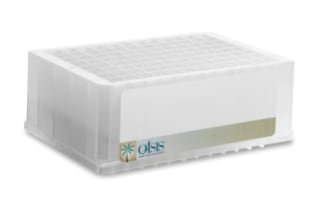
The Oasis MAX 96-well plate contains the Oasis MAX sorbent, which is a novel, mixed-mode polymeric sorbent that has been optimized to achieve higher selectivity and sensitivity for extracting acidic compounds with anion-exchange groups. The unique balance of hydrophobicity and water-wettability of the Oasis MAX sorbent means you will never have to worry about poor results if individual wells of the 96-well plate dry out during the critical steps prior to sample loading. The Oasis MAX 96-well plate is designed to be used on many manifold configurations and most robotic liquid handling systems.
|
UNSPSC |
41115712 |
|
Brand |
Oasis |
|
Product Type |
Solid Phase Extraction |
|
Units per Package |
1 pk |
|
Chemistry |
MAX |
|
Endcapped |
No |
|
Format |
96-well Plate |
|
Ion Exchange Capacity |
0.2 meq/gram |
|
Mass Spec Compatibility |
Yes |
|
Mode |
Mixed mode |
|
Particle Size |
30 µm |
|
Pore Size |
80 Å |
|
Sorbent Substrate |
Copolymer |
|
Sorbent Weight |
30 mg |
|
Water Wettable |
Yes |
|
pH Range Min |
0 pH |
|
pH Range Max |
14 pH |
|
Material |
Polypropylene |
|
Number of Wells |
96 |

Oasis MAX 96-well Plate, 30 mg Sorbent per Well, 30 µm, 1/pk
Oasis MAX was developed to overcome the limitations faced by chromatographers using traditional silica-based mixed-mode SPE sorbents. The sorbent is strong mixed-mode anion-exchange, water-wettable, polymeric, and stable from pH 0 to 14. This allows you to use reliable SPE methods in order to detect, confirm, or quantify acidic compounds and/or metabolites in biological fluids. When an SPE procedure uses the selectivity and ruggedness of Oasis MAX, it enables separation of analytes from complex samples into two fractions- acidic compounds and basic/neutral compounds. These fractionated extracts can be analyzed by multiple analysis methods or even varying techniques.
As a derivative of Oasis HLB, Oasis MAX provides dual modes of retention (both reversed-phase and ion exchange retention modes), which allows greater cleanup selectivity and sensitivity in basic and acidic compounds, respectively. In addition to the benefits seen in Oasis HLB, this sorbent has the ability to retain and release strong bases (like quaternary amines) and strong acids (like sulfonates).
Through a unique and well-controlled production process, Waters is able to reproducibly deliver Oasis MAX with 0.25 meq/g of quarternary-amine-ion-exchange capacity, available in both 30 µm and 60 µm particle sizes. All Oasis 96-well plates offer an innovative two-stage design and work with most liquid handling robotic systems to deliver automated, reliable high throughput SPE. You might wish to utilize the related QuanRecovery with MaxPeak, 700 µL Plates, 25/pk, also available from Waters.
What Is The Difference Between Acidic, Basic, And Neutral?
Aqueous solutions are measured on a scale known as the pH scale, ranging from 0 to 14. A neutral solution has a pH of 7, while acids have a pH below 7. Anything above a 7 is a basic pH value- bases can also be split into weak and strong bases depending on where they fall on the scale. Basic solutions can also be called alkaline. Where a solution falls on the pH scale is a reflection of the concentration of hydrogen ions compared to the concentration of hydroxide ions in that solution.